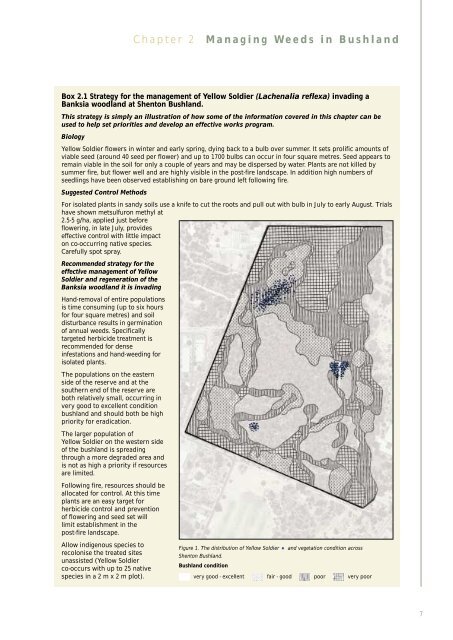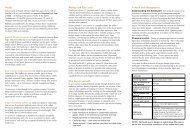Bushland Weeds Manual - Environmental Weeds Action Network
Bushland Weeds Manual - Environmental Weeds Action Network
Bushland Weeds Manual - Environmental Weeds Action Network
You also want an ePaper? Increase the reach of your titles
YUMPU automatically turns print PDFs into web optimized ePapers that Google loves.
Chapter 2 Managing <strong>Weeds</strong> in <strong>Bushland</strong><br />
Box 2.1 Strategy for the management of Yellow Soldier (Lachenalia reflexa) invading a<br />
Banksia woodland at Shenton <strong>Bushland</strong>.<br />
This strategy is simply an illustration of how some of the information covered in this chapter can be<br />
used to help set priorities and develop an effective works program.<br />
Biology<br />
Yellow Soldier flowers in winter and early spring, dying back to a bulb over summer. It sets prolific amounts of<br />
viable seed (around 40 seed per flower) and up to 1700 bulbs can occur in four square metres. Seed appears to<br />
remain viable in the soil for only a couple of years and may be dispersed by water. Plants are not killed by<br />
summer fire, but flower well and are highly visible in the post-fire landscape. In addition high numbers of<br />
seedlings have been observed establishing on bare ground left following fire.<br />
Suggested Control Methods<br />
For isolated plants in sandy soils use a knife to cut the roots and pull out with bulb in July to early August. Trials<br />
have shown metsulfuron methyl at<br />
2.5-5 g/ha, applied just before<br />
flowering, in late July, provides<br />
effective control with little impact<br />
on co-occurring native species.<br />
Carefully spot spray.<br />
Recommended strategy for the<br />
effective management of Yellow<br />
Soldier and regeneration of the<br />
Banksia woodland it is invading<br />
Hand-removal of entire populations<br />
is time consuming (up to six hours<br />
for four square metres) and soil<br />
disturbance results in germination<br />
of annual weeds. Specifically<br />
targeted herbicide treatment is<br />
recommended for dense<br />
infestations and hand-weeding for<br />
isolated plants.<br />
The populations on the eastern<br />
side of the reserve and at the<br />
southern end of the reserve are<br />
both relatively small, occurring in<br />
very good to excellent condition<br />
bushland and should both be high<br />
priority for eradication.<br />
The larger population of<br />
Yellow Soldier on the western side<br />
of the bushland is spreading<br />
through a more degraded area and<br />
is not as high a priority if resources<br />
are limited.<br />
Following fire, resources should be<br />
allocated for control. At this time<br />
plants are an easy target for<br />
herbicide control and prevention<br />
of flowering and seed set will<br />
limit establishment in the<br />
post-fire landscape.<br />
Allow indigenous species to<br />
recolonise the treated sites<br />
unassisted (Yellow Soldier<br />
co-occurs with up to 25 native<br />
Figure 1. The distribution of Yellow Soldier • and vegetation condition across<br />
Shenton <strong>Bushland</strong>.<br />
<strong>Bushland</strong> condition<br />
species in a 2 m x 2 m plot). very good - excellent fair - good poor very poor<br />
7



